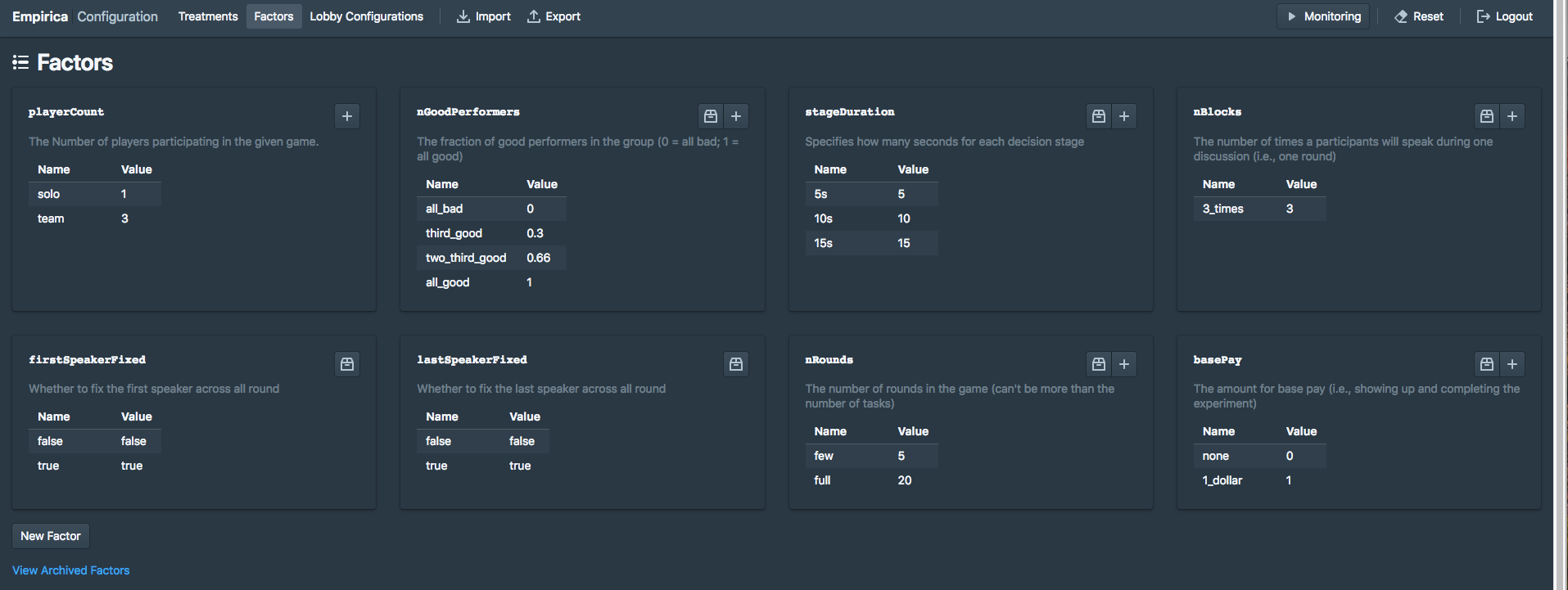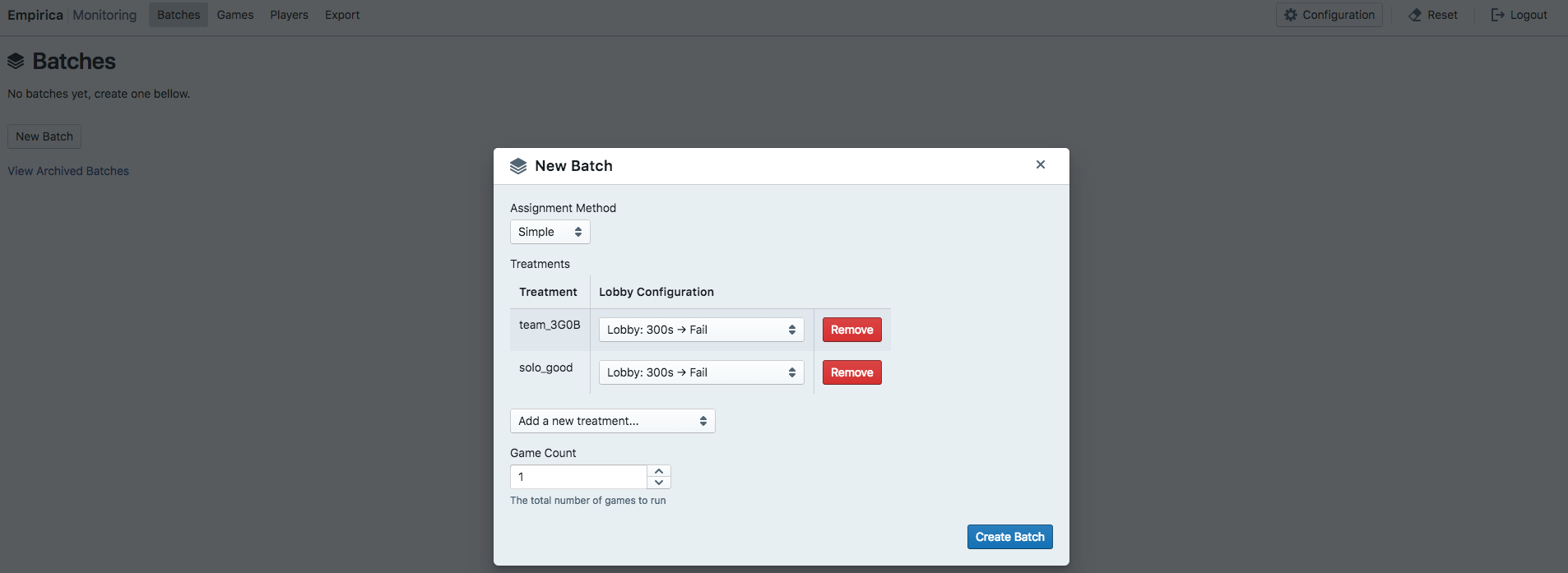This is an experiment powered by Empirica as a follow-up for the model developed in Moussaïd M et al. (2018) Dynamical networks of influence in small group discussions.
In this experiment, groups of N=3 participants simultaneously undertake a visual perception task similar to the one implemented in Moussaïd, et al. (2017). Reach and speed of judgment propagation in the laboratory, PNAS. Participants are exposed to visual stimuli consisting of a set of moving dots. A proportion of correlated dots move in a specific direction θ, and the remaining proportion of uncorrelated dots moved in random directions. Here, θ is the true value that participants have to estimate visually. The value of θ is the same for all the group members.
In the planned experiment, each group undertakes a series of “discussions” (each discussion is a Round from the point of view of Empirica). Within a given discussion round, the true value of θ remains unchanged. Each participant is given the chance to speak 3 times within a single discussion. Therefore, a single discussion round consists of 9 speaking stages (3 players each speaking 3 times), during which the participants share their current estimate with the rest of the group.
Calling A, B, and C the three participants. One discussion (the stimuli is always displayed on the participants’ screens) goes as follows:
- Stage 1
- A, B, and C enter their estimate
- The estimate of A is displayed on all screens
- Stage 2
- A, B, and C can revise their estimate
- The new estimate of B is displayed on all screens
- Stage 3
- A, B, and C can again revise their estimate
- The estimate of C is displayed on all screens ... ...
- Stage 9
- The experiment continues until stage 9 is reached (i.e., everyone spoke 3 times)...
- Stage 10
- A summary of the scores that all participants have made in each stage is displayed on the screens.
- A new discussion round (with a different true value θ) starts.
We set 9 speaking stages per discussion round and NR=20 discussion rounds per group.
The sequence of speaking turns determines which estimate is communicated at a given stage. It is generated using a simple random procedure: For each block of 3 stages, the speaking order is a random permutation of the 3 participants. That is, each participant speaks one and only one time in each block. With 9 speaking rounds, we have three blocks. Each participant thus speaks 3 times during the discussion round, as we mentioned earlier.
We vary the difficulty of the task between participants. That is, some group members will face an easy task — with a high proportion of correlated dots (e.g., 60%), whereas others will face a difficult task with a low proportion of correlated dots (e.g., 10%). The value of θ is the same for all the group members, irrespective of the difficulty level.
The difficulty level is fixed for the entire duration of the experiment.
You and a group of friends can play with this experiment as we ran it by following these instructions (assuming you have Meteor installed):
- Download the repository (and unzip). Alternatively, from terminal just run:
git clone https://github.com/amaatouq/small-group-discussion
- Go into the folder with
cd small-group-discussion - Install the required dependencies
meteor npm install - Edit the
adminpassword in the settings filelocal.jsonto something you like. - Run the local instance with
meteor --settings local.json - Go to
http://localhost:3000/admin(or whatever port you are running Meteor on). - login with the credentials username:
adminand the password you have inlocal.json - Start a new batch with whatever configuration you want (see the example configuration).
First, you have to enter the Configuration mode instead of the Monitoring model in the admin UI.
This will allow you to configure the experiment: Factors, Lobby, and Treatments:
Now, you have the option to create your own configuration (see below) or load an example configuration by clicking on import and then choosing the file ./example-config.
Loading the example configurations will choose some example values for the factors (i.e., independent variables), lobby configuration, and few treatments.
The example factors will look like this:

And the example treatments will look like this:

Finally, you can go back to the Monitoring mode:
Now the Batchs tab make sure you add a new batch, add the treatments you want, choose your lobby configurations, and then start the batch.
Go to http://localhost:3000/ and enjoy! If you don't have 3 friends to play with you, you always can use the new player button in development (for more details see this), which can add an arbitrary number players to the experiment while staying in the same browser (i.e., no need to open different browsers).
The experiment is built with Empirica, which is based on Meteor web development framework. In Empirica, the code is split in 2 main categories: code running on the client (the browser) and code running on the server. This functional separation is immediately reflected in the folders structure.
All code in the /client directory will be ran on the client. The entry point
for your app on the client can be found in /client/main.js. In there you will
find more details about how to customize how a game Round should be rendered,
what Consent message and which Intro Steps you want to present the players
with, etc.
The HTML root of you app in /client/main.html shouldn't generally be changed
much, other than to update the app's HTML <head>, which contains the app's
title, and possibly 3rd party JS and CSS imports.
All styling starts in /client/main.less, and is written in
LESS, a simple superset of CSS. You can also add a plain
CSS files in /client.
The /client/game, /client/intro, /client/exit directories all contain
React components, which compose the UI of your app.
If you are new to React, we recommend you try out the official
React Tutorial.
Server-side code all starts in the /server/main.js file. In that file, we set
an important Empirica integration point, the Empirica.gameInit, which allows
to configure each game as they are initiated by Empirica.
From there we import 2 other files. First the /server/callback.js file, which
contains all the possible callbacks used in the lifecycle of a game. These
callbacks, such as onRoundEnd, offer powerful ways to add logic to a game in a
central point (the server), which is often preferable to adding all the logic on
the client.
Finally, the /server/bots.js file is where you can add bot definitions
to your app.
The /public is here to host any static assets you might need in the game, such
as images. For example, if you add an image at /public/my-logo.jpeg, it will
be available in the app at http://localhost:3000/my-logo.jpeg.
We generated a basic settings file (/local.json), which should originally only
contain configuration for admin login. More documentation for settings is coming
soon.
You can run the app with the settings like this:
meteor --settings local.jsonAs new versions of Empirica become available, you might want to update the version you are using in your app. To do so, simply run:
meteor update empirica:core- Empirica Website: https://empirica.ly/
- Meteor Tutorial: https://www.meteor.com/tutorials/react/creating-an-app
- React Tutorial: https://reactjs.org/tutorial/tutorial.html
- LESS Intro: http://lesscss.org/#overview
- JavaScript Tutorial: https://javascript.info/





